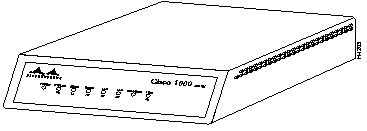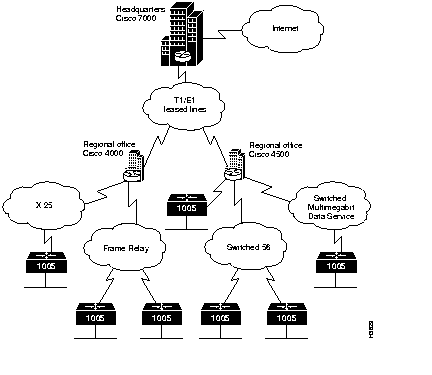The Cisco 1005 router is a small desktop router that links small remote sites with Ethernet LANs to regional and central offices through WAN connections.
The router includes the following features:
- One Ethernet 10BaseT port (RJ-45)
- One console port (RJ-45)
- One serial port (DB-60) that supports the following types of WAN communications:
- Permanent and switched synchronous WAN links at speeds up to 2.048 Mbps
- EIA/TIA-232 asynchronous WAN links at speeds up to 115.2 kbps
- One slot for an optional Personal Computer Memory Card International Association (PCMCIA) Flash memory card
- Software boot using Trivial File Transfer Protocol (TFTP) over an Ethernet LAN connection or by using the optional Flash memory card
- Internet Protocol (IP), Internetwork Packet Exchange (IPX), and AppleTalk routing
- Transparent bridging, which supports protocols that cannot be routed
- Support for the following WAN encapsulations: Point-to-Point Protocol (PPP), High-Level Data Link Control (HDLC), Link Access Procedure Balanced (LAPB), Frame Relay, Switched Multimegabit Data Service (SMDS), and X.25
- Router management through the console port or over the network using Simple Network Management Protocol (SNMP) or Telnet
- AutoInstall for downloading configuration files automatically over a WAN
Figure 1-1 illustrates the Cisco 1005 router.
Figure 1-1: Front View of the Cisco 1005

Figure 1-2 illustrates a typical internetwork using the Cisco 1005 router.
Figure 1-2: Example of the Cisco 1005 in a Network

The specifications of the router are listed in Table 1-1.
Table 1-1: System Specifications
| Description
| Specification
|
|---|
| Dimensions (H x W x D)
| 1.75 x 8.0 x 8.3" (4.4 x 20.3 x 21.1 cm)
|
| Weight
| 2.6 lb (1.2 kg)
|
Input voltage, frequency,
and power dissipation
| 12 VDC output, minimum 0.5A
External power supply: 100-240 VAC at 50-60 Hz, 1.0A input
|
| Memory
| 4-MB DRAM1 SIMM2
1-MB boot PROM3
8-KB NVRAM4
|
| WAN interface
| 1 serial (DB-60)5
|
| Ethernet interface
| 1 10BaseT (RJ-45)
|
| PCMCIA slot
| 1 Type 2 (for Flash ROM card)
|
| Console interface
| 1 asynchronous serial (EIA/TIA-2326) (RJ-45)
|
| Operating environment
| 32-104×F (0-40×C)
|
| Operating humidity
| 10-90%, noncondensing
|
| Agency compliance
| FCC Class B, VCCI Class 2, CISPR-22 Class B, EN 55022 Class B
|
1
DRAM = dynamic random-access memory.
2
SIMM = single in-line memory module.
3
PROM = programmable read-only memory.
4
NVRAM = nonvolatile random-access memory.
5
The serial port supports the following synchronous interfaces: EIA/TIA-232, EIA/TIA-449, V.35, X.21, and EIA-530. The serial port supports EIA/TIA-232 asynchronous interfaces.
6
EIA/TIA-232 and EIA/TIA-449 were known as recommended standards RS-232 and RS-449 before their acceptance as standards by the Electronic Industries Association (EIA) and Telecommunications Industry Association (TIA).
This equipment is in the 2nd Class category (information equipment to be used in a residential area or adjacent area thereto) and conforms to the standards set by the Voluntary Control Council for Interference by data processing equipment and electronic office machines aimed at preventing radio interference in such residential area. When used near a radio or TV receiver, it may become the cause of radio interference. Read the instructions for correct handling.



